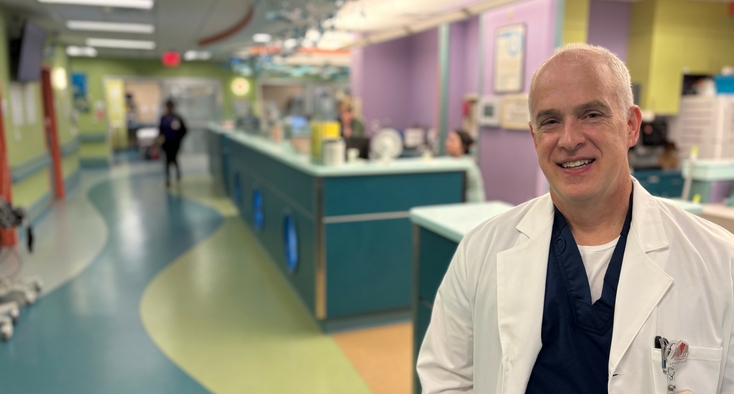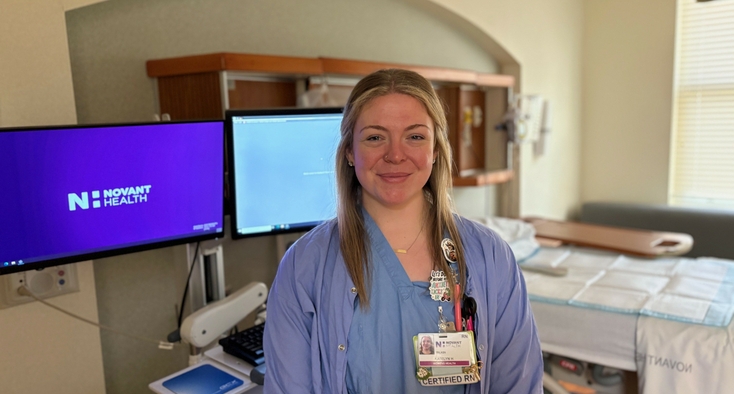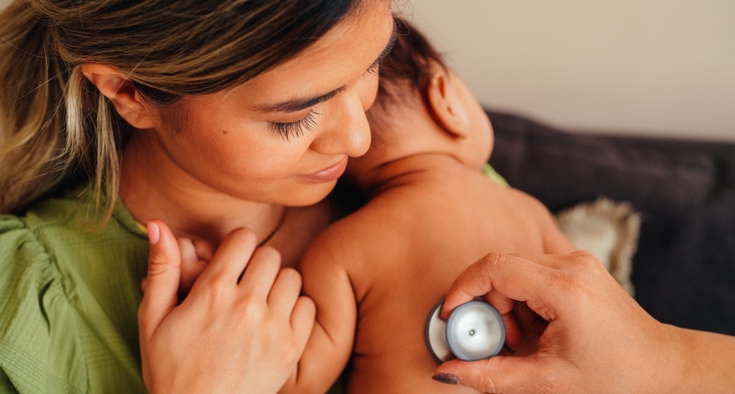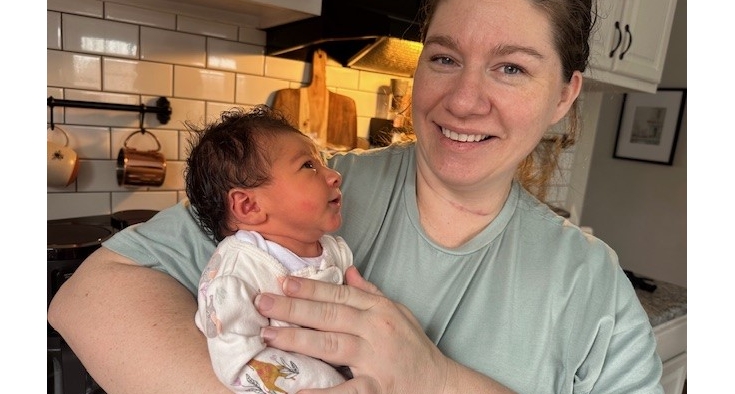Pediatric ER doctors often treat sick or injured patients too young to say what’s wrong. They need to figure out the issue fast. And the parents are often frantic.
Those aren’t ideal conditions to focus and make critical decisions, but it’s just another day at the office for Dr. Doug Boertje (pronounced bor-CHAY), a pediatric emergency room doctor at Novant Health Hemby Children’s Hospital at Presbyterian Medical Center. He’s part of a team that treated 19,567 cases in 2024.
Twenty-three years of experience in pediatrics – 21 of those in the pediatric ER and 17 years in Hemby Children’s Emergency Department – have honed his approach. Asking the right question and building trust fast are part of the secret sauce he relies on in the never-ending drive to get the best possible outcome.
“In emergency pediatrics, you have two or three patients – the child and one or both parents,” Boertje explained. “Kids tell you – and it may not be in words – how they’re feeling. If they're feeling bad, they show it. And if they’re in distress, they don’t hide it. They don’t want to color, play or eat their favorite foods. They may not be able to tell you their tummy hurts or their head hurts, but parents know. When I ask parents: ‘What do you think is hurting?’ they’re right 99% of the time.”
Your child deserves the best pediatric care. Find it now.
Amanda Reulbach, nurse manager in the pediatric ER, has seen Boertje treat young patients while comforting their parents countless times in the nearly nine years they’ve worked together. “Dr. B never fails to strike the perfect balance between ensuring patient safety and well-being but also demonstrating compassion and providing reassurance to parents on what is often the scariest day of their lives,” she said. “He does not take lightly that parents have entrusted him to care for what is most precious to them.”
Asking the right questions
He tries to reassure parents, if he truthfully can.
“If I can honestly say it, I’ll tell parents their child is going to be OK,” he said. “They're scared; we’re seeing people on what feels like their worst day ever. So, you take a moment to gain their trust so they feel comfortable sharing their child’s medical history. I’m a talker, so I've learned over the years to let them finish. Sometimes they'll say something they think isn’t relevant, and you go: Wait, what? That’s exactly what I needed.”
The last question he asks often turns out to be the most important one: What concerns do you have that we haven't discussed?
He once met patients – a toddler and her dad. She’d been recently treated for vomiting. When Boertje asked the dad if he had any final questions, the father asked, “What about the fussiness? She'll cry really loud sometimes and vomit right after. It’ll last a few minutes, and then she's fine.”
There’s nothing unusual about a fussy toddler, so the parent hadn’t thought to mention it earlier. But it was the most significant clue Boertje had that there was a more serious issue going on.
If a parent mentions intermittent fussiness in their toddler with fatigue in between, Boertje suspects intussusception – a rare, but serious, condition in which part of the intestine slides into another part. “When a toddler cries, they're bearing down on their abdomen,” he explained. “That pushes the bowel back to where it’s supposed to be, but it goes right back. Children have a brief reprieve where it's a little better, but it comes right back.”
An ultrasound confirmed his hunch, and the little girl was treated and released. In about 90% of cases, treatment – usually an enema with air and contrast performed by a radiologist – works, and no further treatment is needed. In the 10% of cases where treatment doesn’t work, a pediatric surgeon will need to take the child to the OR for surgery. (Note: Boertje said parents should not try the enema at home with an over-the-counter product. That won’t fix a problem this serious.)
What’s up, Doc?
Boertje is a natural at his job. Even his friends in middle school could see him going into medicine; they gave him the nickname “Doc.”
“I never went through the ‘I-want-to-be-a-fireman-or-astronaut’ phase,” he said. “It was always medicine.”
During his medical training, the lesson mentors kept repeating was: Listen to the parents.
Parents will often share their fears, both real or imagined, with Boertje. Sometimes, their fears come from Googling their child’s symptoms. He strongly discourages that. “I remind parents that Google gets paid by clicks,” he said. “It’s going to go to a dark place quickly.”
When the patient is too sick to talk
Pediatric emergency doctors and nurses have to know how to talk to toddlers, tweens and teens.
“The Novant Health nurses are great about communicating with kids of all ages,” Boertje said. “We’re lucky to have Child Life specialists who help all of us understand what kids of different ages can comprehend. We all recognize that coming to the ER can be a crisis for the kid and the parent.”
When Whitney Hamilton brought her son, Elijah, then 3, to Hemby’s ER in February 2024, he was critically ill and unable to interact at all. “I could see fear in his mom’s face right away. He had such a high fever – it was 105 – and was lethargic and having seizure activity. When examining a toddler, they hate every bit of that and will try to push you away. Elijah didn’t resist.”
Boertje recalls Elijah’s mom that day as “phenomenal, very calm.” (That’s not how she remembers it. See sidebar.)
A high fever and continued seizure activity could signal meningitis. That would’ve been the worst-case scenario, Boertje said. “A seizure caused by a high fever is fairly common,” Boertje said. “I had febrile seizures as a kid. For Elijah, it was the fact that he continued to seize for such a long time.”
He explained to Hamilton everything he was doing before he did it. “I’m worried about an infection, so we’re going to do bloodwork; it’ll take 30 to 40 minutes to get results,” he told her. Then, he explained, “We’ll do a CT scan, which is quick and painless, and we’ll get those results quickly. Then, we’ll do a lumbar puncture to test for meningitis. Next, we’ll place an IV so we can begin antibiotics.”
The CT scan was done to ensure Elijah didn't have a brain bleed or tumor. Both seemed unlikely, but neither could be ruled out yet because he was so sick.
“With any critically ill patient, I’m trying to get as many puzzle pieces on the table as I can before we send the child to the PICU (Pediatric Intensive Care Unit),” he said. If a child isn’t treated and released from the ER, they’ll either go to the pediatric inpatient unit or the PICU. Elijah was in the Hemby PICU for a month.
Once in the PICU, an MRI showed what a CT scan couldn’t. Elijah had encephalitis, a life-threatening brain inflammation. Boertje had been on the right track with meningitis but “had the wrong layer of infection,” he said. Meningitis and encephalitis are close cousins.
“When Elijah left the ER, he was breathing on his own,” Boertje said. “But in the PICU, he got much sicker and had to be intubated.” In other words, he was on life support.
‘Thank you’ means the world
The time ER doctors spend with patients is generally no more than an hour or two. They move from one crisis to the next. So, Boertje was amazed when Elijah and his mom returned to the ER and PICU to thank the team that saved him.
“Our time together was brief,” Boertje said. “For Mom to recognize that Elijah’s care started in the ER is so rare and really speaks to her character and her heart. ER medicine is hard. We’re moving fast, and our time with each patient is pretty limited. So, we don't get a lot of patient feedback. For Whitney and Elijah to come back to say ‘thank you’ means the world.”
Reulbach, the nurse manager, who described Boertje as “passionate, committed, compassionate and hilarious,” said he’s mastered the art of moving quickly while also not rushing parents. He’s got to act with a sense of urgency while not further alarming parents. “He never forgets there is a terrified parent at the bedside,” she said. “Even with the most critically ill child, Dr. Boertje calmly and clearly communicates to the parent what the plan is while also never missing an opportunity to provide reassurance.”
Neither does he forget that every encounter involves two (or more) patients – a sick child and a parent who’s sick with worry. “In that room that day, I had two patients – Elijah and his mom,” he said. “They had very different needs, and I’m always going to do my best to meet the needs of both.”
‘Superman mode’
The mom of critically ill 3-year-old calls his ER doctor a hero
In February 2024, Whitney Hamilton left home to pick up one of her five children from school. She’d kept her youngest, Elijah, home from preschool that day because he had a low fever and left him with his older sister. During the short time Hamilton was gone, her daughter called to say Elijah had vomited and that “his eyes rolled to the back of his head.”
She told her daughter to go get a neighbor. Then, she called 911 and rushed home. When medics arrived, Elijah was having seizures.
Once they reached the children’s ER at Novant Health Presbyterian Children’s Hospital, the panicked mom and her critically ill 3-year-old met Dr. Doug Boertje. “He immediately went into Superman mode,” she recalled.
Boertje’s recollection is that Hamilton was amazingly calm. Hamilton, however, recalls being frantic (“Elijah was so sick, and there’s no way a mother can prepare for that”) and remembers Boertje as the calming influence.
“I was crying; I didn't know what to do,” she said. “Dr. Boertje kept saying, ‘You have to be strong for him. If you break down, what’s your son going to do?’ I'll never forget that moment. I wiped my tears and decided I had to be strong for Elijah.”
Most children who come to the ER go home after treatment, but Elijah was too sick. The PICU became his home for the next month. On a particular difficult day, Hamilton walked to the hospital parking lot and made a deal with God: If Elijah could get well enough to go home, she’d give up an unhealthy habit she’d had since she was 14.
“And here I am: 37 years old,” she said. “I haven’t broken my vow since that day. I made a bargain with God because you can't ask for something without giving something back.”
An aggressive course of steroids was ultimately what got Elijah well enough to go home. But first, he needed rehab at Hemby. That included speech, physical and occupational therapy.
He still has some deficits, but he’s much improved from a year ago. “Elijah can walk, talk, eat, run and use the bathroom by himself,” his mom said. “And he couldn’t do any of those things in the PICU. Today, he has some minor delays and weakness on his left side, but he’s resilient. I have faith he’ll make a full recovery.”
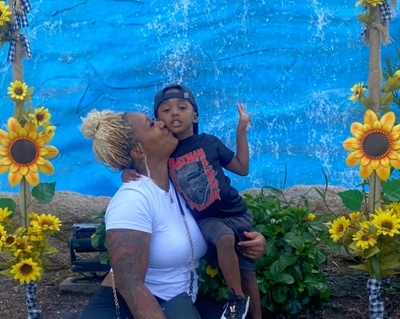
Elijah will be 5 in August, and Hamilton may keep him in preschool another year to work more on his motor skills. She’s left her job to devote herself to her youngest child’s care and rehabilitation. Her philosophy is the same as Boertje’s. “A mother knows her child better than anyone,” she said.
She’s grateful for the medical team that saved her son – grateful enough to have returned to the ER and PICU to thank them. But she said, “There’s nothing like a mother.”





